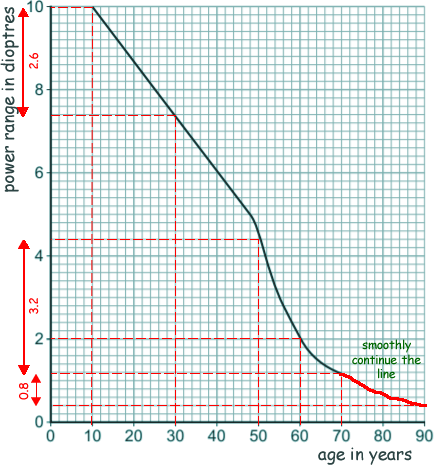GCSE level optics questions
Q21. The diagram shows a human eye.

(a) Label the parts A and B on diagram.
A is the suspensory ligament 
B is the retina 
[2 marks]
(b) State the function of the iris.
The iris controls the amount of light entering the eye  and thereby the amount of light incident on the retina.
and thereby the amount of light incident on the retina.
[1 mark]
(c)

(i) Give the name of the defect of vision shown in the diagram above.
Short sight or myopia 
[1 mark]
(ii) A concave (diverging) lens can be used to correct the defect of vision shown in the diagram.
Complete the ray diagram below to show how a concave lens produces an image of the object. Use an arrow to represent the image.

[3 marks]
(d) It is important that muscles can change the power of the lens in the eye. State why.
So that they can focus light from objects at different distances from the eye onto the retina. 
[1 mark]
(e) The 'power range' of an eye lens is the difference between the maximum and minimum power of the lens.
The graph shows how the power range of an eye lens changes with age.

(i) Use data from Figure 9 to calculate the maximum change that can happen to the focal length of the eye lens for a 60-year-old person. Give the unit.
Power range = 2 D
P = 1/f
f = 1/P
f = 1/2
f = 0.5  m
m 
[2 marks]
(ii) Compare the change in power range of the eye lens between the ages of 10 and 30 with that between the ages of 50 and 70.
The 10 to 30 age change decreases at a constant rate by 2.6D, whereas the 50 to 70 age change falls faster than the younger rate from 50 to 60, and then less rapidly after 60 years, with a total fall of 3.2D.
whereas the 50 to 70 age change falls faster than the younger rate from 50 to 60, and then less rapidly after 60 years, with a total fall of 3.2D.
Therefore the deterioration of eyesight in the 20 years from 50 to 70 is much larger than the deterioration during the 20 year interval between the age of 10 and 30.
[3 marks]
(iii) Use the graph to suggest the power range of the eye lens for a 90-year-old person.
Any answer in the range of 0.6 D to 1.0 D got you the mark.
0.8 D 
[2 mark]
(Total 15 marks)










